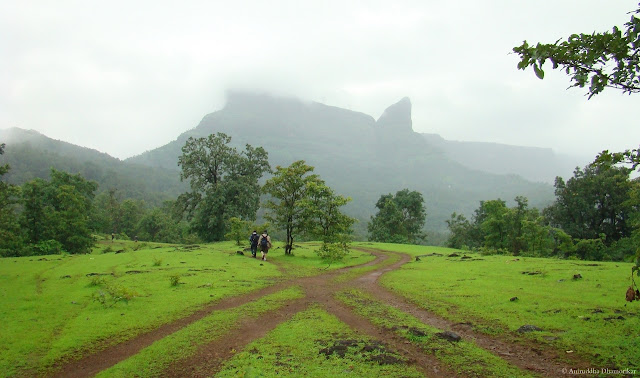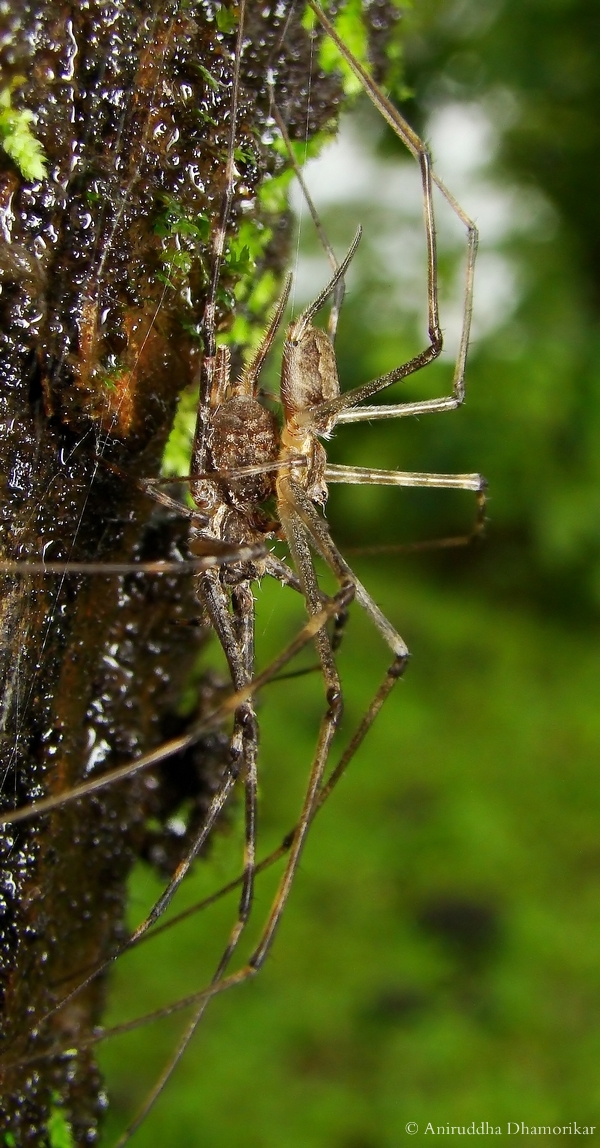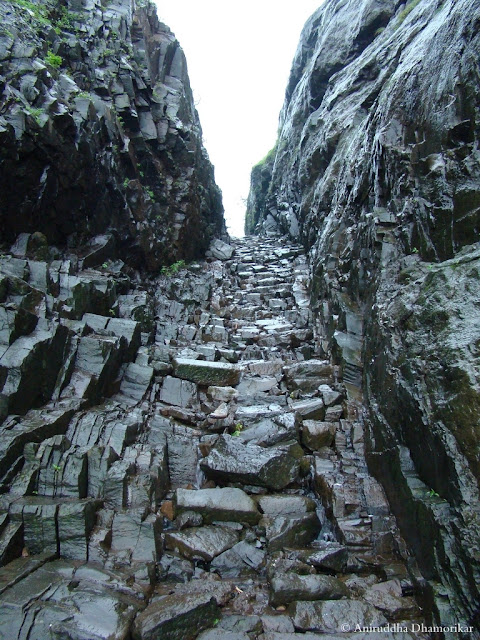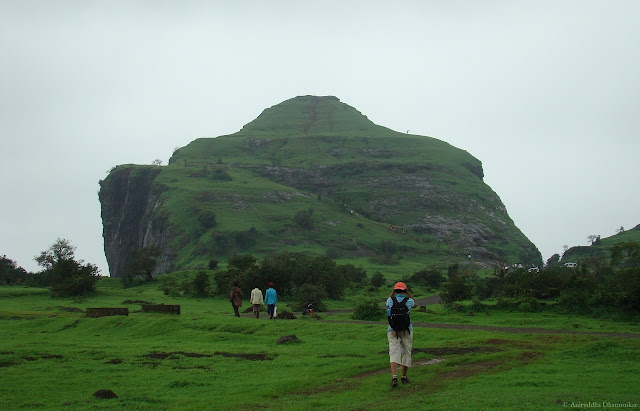On the eve of Independence Day, we set on a long road trip to a really unique destination in the northern Western Ghats called Naneghat. Naneghat literally means Coin-passage. It has an interesting history behind the name. It was used as a trading route centuries ago between Kalyan and Junnar. In those times, coins were collected as toll to cross via the pass, and hence the name.
An
aerial view of Naneghat gives a fantastic look at its geography. It is a fascinating landmark in the northern Western Ghats well known throughout the history. But that’s not it. Naneghat was a passage not only for our ancestors, but many, many other creatures small and large that could not tread the sheer drop from the plateau.
As we went on to explore this historically significant landmark, we enthusiastically scoured the biodiversity of this region, which is rather pristine, and came to a point of exhaustion where all that mattered was reaching the end. Let’s take a look as we lost our way amidst the beauty and reached the edge of the cliff of this Sahyadri range called Naneghat:
 |
| Naneghat: The Beginning |
Our journey began with much delight. As soon as we had our cameras ready, we saw an Indian Grey Hornbill sitting preening itself on a tall, bare tree:
 |
| Good Morning, Mr. Hornbill (and a Red-vented Bulbul) |
It sat quite far for my camera’s reach, but sighting a Hornbill sitting in the open was a sure sign that Naneghat has a lot of offer. Very soon, we were walking on an empty path surrounded by lush green grass and broad-leaved Teaks. As always, I was lagging quite behind the company, trying to find some creature amidst this darkening landscape. I have a habit of scanning tree trunks for several seconds, especially those that are dark and rough in texture – such places are excellent to observe these:
 |
| Hersilia sp., pair |
Now this is the third time I’ve displayed these spiders within three months – but this one was special, because it was also the first time I saw a male spider copulating a female. If you’ve read the previous
Monsoon Trail articles, you probably know that if you see a female Two-tailed Spider, a male is almost always nearby. This time though, he was piggybacking her – a behaviour common throughout all spider families. Interestingly, they did not “unite” but he sure was trying to persuade her. After copulation, the female will lay several hundred eggs in a depression on the tree trunk, and spin the silk around it. She will sit by guarding the egg-case until the spiderlings hatch.
While photographing them, I heard a few shouts by my name and decided to run for it. But I was obstructed by another beautiful creature that is fairly common, but worth seeing every time – a Long-legged Marsh Glider:
 |
| Trithemis pallidinervis, Long-legged Marsh Glider |
As is apparent from its common name, they have rather long hind limbs, which are efficient at catching prey. Now most of the dragonflies have lengthened hind limbs, but I guess it is rather more apparent in this species, especially amongst Libellulids and hence the name.
Very soon it began to drizzle, and I had to pack my gear and catch up with the gang. We crossed several streams to reach a fork in the route, and ended up taking the one that looked most inviting. It had a large patch of beautiful flowers, such as this Martynia annua:
 |
| Martynia annua |
According to Wiki, it is a native of Brazil and was introduced in India (not known when). The fruit is used to mend scorpion sting. Another beautiful, plant just on the edge of the fork was Gloriosa superba:
 |
| Gloriosa superba |
This glorious flower, commonly called Glory Lily, is superb in its morphology. The entire flower is up-side-down, with the petals, instead of pointing downwards; grow against the gravity, creating an illusion of flames. They almost resemble little lamps. Sadly,
G. superba is endangered because it is gregariously harvested for its aesthetic looks and its medicinal values. It is very crucial to protect this fiery lily from being extinct, because its beauty has not only captured our imagination, but it is a valuable plant providing food to a number of insects. Some other findings were Aeginatia indica, a root parasite and
Curcuma sp. Dinesh Valke did a fantastic job of
documenting the flora on the trek.
As we took the path that enters the foothills of Naneghat, we entered a dense ecosystem of the moist deciduous forests. These forests were strewn with a number of streams, and just as we treaded, our path merged with one of the streams – and we became lost. There’s a sense of adventure every time you take the wrong step. Now we weren’t far off the path, and therefore this excitement did not turn into a struggle for survival. I cherished walking in the cold stream surrounded by tall looming trees and with dragonflies everywhere I looked, some of them I’m yet to identify.
 |
| An ideal stream ecology - Dragonfly diversity is an indicator of a healthy ecosystem |
A few of our experienced trekkers soon found a way out, but we were delayed by over an hour. After treading through a pathless landscape for a few minutes, we came into a clearing with a fantastic view of a waterfall, which, for a change, did not have anyone littering it:
 |
| Pristine waterfall |
It was pretty tall, and we knew we’d have to reach the top of it to reach the actual pass in the mountains. I’d be dejected if I had to climb a 20 storey building, but this was an exceptionally beautiful climb. After taking a short break near the falls, I saw this patient Golden Angle basking in the sun:
 |
| Caprona ransonnetti, Golden Angle |
As the Monsoon season wanes, the diversity of these Skippers (family Hesperiidae) increases. Golden Angle is a common skipper inhabiting forested patches, and they’re almost always found near a stream. After a small snack, we resumed our hike though the jungles. We reached a turning point where the path was heavily eroded, and from there it was a rocky climb straight up to the top.
 |
| Little by little |
Strewn with large boulders, probably deliberately cut into steps to serve the purpose, it was hectic but a beautiful climb, with a view exceptionally serene. The Naneghat plateau and the thumb-like projection loomed directly over our heads. Our walk was slowed by intermittent pauses in the forest openings to check the view and get a clear glimpse of where we were headed. Treasure awaited us at the top, a treasure we were hoping to find.
All along the trek, until we reached the very edge of the end of the climb, we were being stalked. It was a very swift stalker – bold and persistent. It was a Horsefly in the genus Philoliche. These large, robust blood-suckers were fairly common along the trek. They are easily identifiable by their large orange abdomen and a typically long mouthpart, shaped much like a sharp needle. Luckily, they do not use this “needle” to puncture you, because it is very elastic. Their real weapon lies much closer to their heads, a saw like two mandibles that they use to cut through flesh. The bites can be pretty painful, but fortunately none of us were bitten that day. Only the females require a bloody diet, since it is nutrient rich and helpful in the development of the young ones. Males primarily feed on nectar.
 |
| Beetle artwork |
On the way we saw some curious carvings over a fallen log. It looked as if someone intentionally carved butterflies on it. Interestingly, it was not the artwork of any man, but a small beetle, more specifically a Wood-boring beetle. The beetle lays eggs in the visible median line when the bark of the tree is intact. The grubs, when they hatch, travel outwards like protruding arms, eating their way until they transform into a pupa. And when the bark of the tree is stripped, this pattern is revealed.
Once we reached the cave system built ages ago, and which is still in use by overnight trekkers, the end was in the sight. The path from here looks something out of a fantasy:
 |
| Climbing up the walls |
Clutched into the shoulder of the broad plateau that stretched far and wide in the opposite directions, this passage was used not only by humans, but by a number of butterflies! I recorded Glassy Tiger, an unidentified Oak Blue, a Common Emigrant, and a Blue Mormon that passed right through this pass into the valley down below. Batches of Barn Swallows were also seen sweeping in into the pass. While I’m not sure if the butterflies got sucked in, into this narrow slope, I’m sure it was not just a pass meant for business, but it was a corridor for animals as well.
 |
| Naneghat and the toll collecting pot |
We had almost completed the trek. We passed the Naneghat and emerged onto the plateau. Our destination was the thumb-like projection that always daunted us from the base. Even when we were close to it, it looked ginormous:
 |
| The final climb with Naneghat pass to the right |
Plateaus like this are common along the Sahyadri ranges. It is on these tall plains that many endemics of Western Ghats are found. As we explored the region saturated with rainwater, we came across these beautiful aquatic herbs, Pogostemon decannensis:
 |
| Pogostemon deccanensis and a little Grasshopper nymph |
A little Grasshopper nymph sat prettily on this plant. These fresh green little plants are common in such high terrains where there is plenty of water. As we climbed up and higher, we came across an interesting beetle that loves to roll into dung:
 |
| Dung Beetle, family Scarabaeidae |
It is a Dung Beetle, and there were at least ten of them on a small pile. All they were doing is making a perfect roll of the dung and carrying it away in order to lay an egg. Since there were so many, it must have been a fierce competition, and Dung Beetles are well known to compete and steal other’s dung balls. I hope everyone got at least one from what was left of that poop, rather, a resource. It also shows how important they are to clean up the grasslands.
 |
| Fifteen steps then a sheer drop |
Soon we were at the very top. As we enjoyed the landscape from this high-rise, I saw a few flowers waving blissfully in the wind. It was, to our surprise Ceropegia rollae:
 |
| Ceropegia rollae |
I already discussed another species, C. lawii, which was formerly wrongly identified as C. sahyadrica, to be an endangered plant found in these regions. C. rollae shares the same fate. A little lower, nicely resting on the edge of the sheer drop was a garden of C. rollae:
 |
| The garden of C. rollae |
Our treasure had been found. It was just a plant, something growing right under the nose of a number of trekkers who painstakingly climbed to reach the end.
 |
| Jivdham and Khadaparshi |
From the plateau, we could see the Jivdhan fort as well as a long spine, called Khadaparshi looming over Naneghat. It was almost out of JRR Tolkien’s Middle Earth – and I’m not the only one to say this. Khadaparshi looks like a large figure of a king, much like that of the Numenor Kings statues! After spending the time absorbing the beauty of this place, we started treading back, and heard a loud thundering of falling rocks. A small ledge on a nearby slope had given away. It was a landslide. Fortunately, it did not do any damage to human life.
On the way to a hotel, we saw a little Land Crab standing proudly over the domain of his pond:
 |
| Little Land Crab in his domain |
This pond was surrounded by Pogostemon deccanensis, a pretty little landscape that added value to the larger picture, a thousand times bigger in size. We had a snack of poha, pakods and chai, and contemplated climbing all the way down. It was not going to be an easy descent. And we began:
 |
| The Descent |
Step by step, everyone embraced the stony walls of the pass as we looked down into the valley. It was cold and windy, and very soon the rain poured and blurred our vision. The wind that swept up the valley made our descent even more difficult. After passing through the bare rocks, we entered into the forested areas, and just as I passed brushing through long and thin grass blades, I saw a small creature I’m not fond of:
 |
| Tick |
It is a Tick. Ticks are arachnids, known to live solely on the diet of blood. They are notorious little creatures that can cause huge loss to cattle herders, if they swarm. Luckily, Ticks are not much of a problem in this part of the Western Ghats, but those who have been bitten think otherwise. Although Ticks here are not known to spread any diseases, if you’re allergic to their bites, the itch takes years to fade away. By then, you may have developed a phobia of these little buggers, as I did.
After touching the base in the evening, we looked back and saw what we achieved:
 |
| There and back again |
It was an excellent trek through a variety of habitats, from little grasslands to streams, to the dense and humid deciduous forests, and the plateau of Sahyadris. Naneghat is also excellent in terms of its biodiversity, harbouring a rich diversity of flora and fauna. What’s inevitable is the mark that we humans leave behind. Like every place on Earth, Naneghat is also infected with plastic crap in nooks and corners. I strongly recommend visiting Naneghat if you’re fond of roughing it up and exploring the amazing diversity it has to offer.

Beautiful pics Anirudh!...Some of the best I've seen so far..... long time since I had been to Naneghat, but really felt like I was there! Keep up the good work! :)
ReplyDeleteMy oh my, you had a marvelous adventure. The pictures are beautiful. I felt as if you had taken me with you.
ReplyDeleteThank you Prinks and Emma! :)
ReplyDeleteFantastic photos as always Ani! The lone tree on the side of the hill and the land crab surrounded by water are stunning!
ReplyDeleteThanks Morgan. I really appreciate it :)
ReplyDeleteThanks Aniruddha, Very interesting read
ReplyDelete